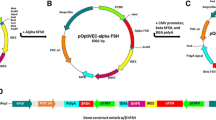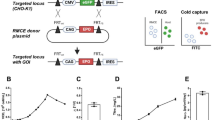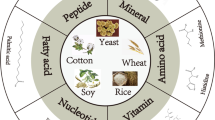Abstract
Recombinant human Factor IX (rFIX) was cloned in a mammalian expression vector and transfected into CHO and HEK-293. Treatment with 10−9 M methyl testosterone increased rFIX production by 30–50% in CHO and HEK clones. However, 10−9 M 17β-oestradiol increased production of rFIX by ~50% in CHO-F7 clone and decreased production by 48% and 37% in CHO-F8 and HEK-F2-6, respectively. Progesterone treatment inhibited rFIX production in both cell lines. Production of rFIX can thus be increased by sex hormone treatment and therefore used to enhance biotechnological production in mammalian cells.
Similar content being viewed by others
Avoid common mistakes on your manuscript.
Introduction
Human Factor IX plays a key role in coagulation and haemostasis (Hamaguchi et al. 1991). The genetic deficiency of this factor results in haemohpilia type B which can be treated by purified Factor IX. The plasma-derived concentrates of Factor IX may expose patients to blood-borne infections such as AIDS, Hepatitis (Berntorp et al. 1996; Mannucci 2003; Azzi et al. 1999). Recombinant Factor IX (rFIX) products are safer and more efficient treatment alternatives (White et al. 1998). Factor IX gene has been cloned and shown to be expressed in hepatocytes with high tissue specificity (Yoshitake et al. 1985).
There is evidence related to the effect of sex hormones on Factor IX expression/function. Recently, case–control studies as well as clinical trials have shown that hormone replacement therapy (HRT) increases the risk of venous thromboembolism 2–4 fold (Daly et al. 1996). The mechanisms are not well defined yet; however, they are probably related to unnaturally high levels of hormone as well as the metabolic consequences of the high hormone concentrations in the hepatic portal vein following oral HRT, which include the hepatic synthesis of proteins involved in coagulation, fibrinolysis and the acute-phase response (Crook 1997). Moreover, oral HRT increases Factor IX levels compared to postmenopausal non-users of HRT (Lowe et al. 2001), suggesting a relation between female sex hormones and FIX synthesis.
Furthermore, the expression of Factor IX undergoes significant developmental regulations throughout life, primarily at the level of transcription. In both human and mice the early post-natal levels of Factor IX are half of adult value and show a subsequent increase during early childhood to around 75% of adult levels (Andrew et al. 1992). The next significant change in Factor IX expression in human occurs during early adulthood, when an increment of 25% has been documented in both sexes beginning at puberty (Sweeney and Hoernig 1993). To complement this observation, a rare form of inherited Factor IX deficiency, haemophilia B Lyden, has been documented to undergo post-pubertal phenotypic resolution (Veltkamp et al. 1970). In this study, we have investigated the effects of hormone treatment with 17β-oestradiol, progesterone and methyl testosterone on rFIX production in CHO and HEK-293 cell lines.
Materials and methods
Construction of expression vector
Factor IX cDNA (NCBI accession number NM-000133) was amplified from human liver cDNA library by means of PCR using Taq polymerase. The PCR product was then subjected to 1% agarose electrophoresis, extracted from gel and ligated into a TA cloning vector, pCR2.1 (Invitrogen). Factor IX cDNA was then directionally cloned into the expression vector, pcDNA3.1 (Invitrogen) and confirmed by sequencing (SEQLAB, Germany) and restriction digests. The corresponding vector, pcDNA3.1-FIX, was grown in DH5α and plasmid was purified for transfection.
Cell culture, transfection and hormonal treatment
CHO and HEK-293 cells (Pasteur Institute Cell Bank, Iran), were maintained in 37°C, 5% CO2 in RPMI (Gibco) supplemented with 10% (v/v) FBS (Gibco). Cells were transfected by FuGENE 6 (Roche) and pcDNA3.1-FIX according to the manufacturer’s manual and the stably expressing clones were isolated in medium containing 50 μg geneticin (Roche)/ml. The resistant colonies were subjected to clonal expansion and screened for FIX production using ELISA. For hormone treatments, cells (5 × 104) were seeded in 12-well plate and treated with 10−6–10−9 M 17β-oestradiol (Sigma), progesterone (Sigma), or 10−7–10−9 M of methyl testosterone (Abureihan Pharmaceuticals, Iran) in RPMI (with 10 μg vitamin K/ml). After 48 h, the medium was harvested for measurement of rFIX production. The FBS used in the medium was depleted of intrinsic Factor IX by barium sulphate treatment (Yao et al. 1991).
Quantification and biological activity of Factor IX
The quantity of Factor IX in the culture media of the transfected colonies was measured by enzyme-linked immunosorbant assay kit (ELISA, AssayPro, USA). The Factor IX concentration in each sample was calculated according to the standard curve of the assay and the results were normalized by cell numbers at the time of sampling. The activity of Factor IX was measured by one-stage clotting assay employing human Factor IX deficient plasma using Sysmex CA-2000 Automated Blood Coagulation Analyzer (Coagulation Laboratory, Iranian Haemophilia Society, Tehran, Iran).
Results and discussion
Production of stably transfected CHO and HEK-293 expressing rFIX
The 36 resistant clones of CHO and HEK-293 were screened for production and function of rFIX by ELISA and one-stage clotting assay, respectively. Results provided 14 clones (10 in CHO and 4 in HEK cells) expressed rFIX in high and 7 clones in medium level (5 in CHO and 2 in HEK cells). Moreover, eight of expressing clones (6 in CHO and 2 in HEK cells) produced functional rFIX with suitable cell growth rate. Our expression result indicated that CHO-F7 was the highest producer of biologically active rFIX (8 × 10−8 μg/cell and 5.28 × 10−5 ± 2.7 × 10−6 mU rFIX per cell in 48 h) with the most suitable proliferation pattern (doubling time = 17 h) compared to other colonies. Thus, this colony was selected for hormonal treatment studies. In addition, two more colonies, HEK-F2-6 (4 × 10−8 μg/cell and 6.25 × 10−5 mU rFIX per cell, doubling time = 40.3 h) and CHO-F8 (4 × 10−8 μg/cell and 2.5 × 10−5 mU rFIX per cell, doubling time 20 h) were selected to further study the effect of hormones on rFIX production.
The effects of sex hormones on rFIX production in CHO
17β-Oestradiol and methyl testosterone treatment showed a dose-dependent effect on rFIX production (Fig. 1). At higher concentration, the hormone treatment inhibited rFIX production; however, reducing hormone concentration blocked the inhibition in a dose-dependent manner. rFIX production in CHO-F7 cells treated with 10−9 M 17β-oestradiol and 10−9 M methyl testosterone increased by ~40% and 50%, respectively (Fig. 2). These results suggest a dose-dependent inhibitory-stimulatory effect of these hormones on the rFIX expression. On the other hand, progesterone treatment blocked rFIX production in 10−6–10−9 M, suggesting an inhibitory effect on rFIX production. The effects of 10−9 M 17β-oestradiol and methyl testosterone treatment were studied on CHO-F8 (Fig. 3). The results indicated a similar effect for testosterone (27% increase). However, the 17β-oestradiol treatment lowers production to almost half of control which is different form CHO-F7 clone, suggesting perhaps a clonal variation for this hormonal effect.
Effects of different concentrations of 17β-oestradiol, progesterone and methyl testosterone on production of rFIX by CHO-F7. CHO-F7 cells were seeded at 50,000 cells per well in a 12-well plate. After 48 h, cells were treated with 10−6–10−9 M 17β-oestradiol and progesterone, and 10−7–10−9 M methyl testosterone in RPMI (with 10% barium-treated FBS and 10 μg vitamin K/ml). Three wells were kept as control. After 48 h, the amount of rFIX was determined for each sample and normalized by cell number. The results are expressed as percent of control (7.4 × 10−8 ± 2.8 × 10−8 μg rFIX per cell)
Effects of 10−9 M 17β-oestradiol and methyl testosterone on production of rFIX by CHO-F7. Cells were seeded (50,000/well) in a 12-well plate, after 48 h, 17β-oestradiol (oestrogen, 10−9 M) and of methyl testosterone (M testosterone, 10−9 M) in RPMI (with 10% barium-treated FBS and 10 μg vitamin K/ml) were added in triplicate and 3 wells were kept as control. After another 48 h the amount of rFIX was determined for each sample and normalized by cell number. The results are demonstrated as mean ± SE (n = 3). Data were analyzed by means of repeated measure one way ANOVA and post test of Tukey (* indicates P < 0.05)
Effects of 10−9 M 17β-oestradiol and methyl testosterone on production of rFIX by CHO-F8. Cells were seeded (50,000/well) in a 12-well plate, after 48 h, 17β-oestradiol (oestrogen, 10−9 M) and of methyl testosterone (M testosterone, 10−9 M) in RPMI (with 10% barium-treated FBS and 10 μg vitamin K/ml) were added in duplicate and 2 wells were kept as control. After another 48 h the amount of rFIX was determined for each sample and normalized by cell number. The results are demonstrated as percent of control (2.7 × 10−8 μg rFIX per cell)
The effects of sex hormones on rFIX production in HEK
HEK-F2-6 treatment with 10−9 M 17β-oestradiol did not increase production (Fig. 4), however, 10−9 M methyl testosterone induced a 30% increase in rFIX production. Bearing in mind that CHO cells are responsive to 17β-oestradiol and progesterone owing to their ovarian origin, the effects of sex hormones were more pronounced in CHO clones compared with HEK cells.
Effects of 10−9 M 17β-oestradiol and methyl testosterone on production of rFIX by HEK-F2-6. Cells were seeded (50,000/well) in a 12-well plate, after 48 h, 17β-oestradiol (oestrogen, 10−9 M) and of methyl testosterone (M testosterone, 10−9 M) in RPMI (with 10% barium-treated FBS and 1,010 μg vitamin K/ml) were added in duplicate and 2 wells were kept as control. After another 48 h the amount of rFIX was determined for each sample and normalized by cell number. The results are demonstrated as percent of control (9.7 × 10−8 μg rFIX per cell)
It is difficult to specify the exact mechanism of alteration in rFIX production observed in our recombinant cell lines; however one can suggest alteration on transcriptional and/or translational levels as the underlying cause of this observation. In other words, hormones can affect FIX production directly or indirectly on the protein expression or protein degradation. Nonetheless, one can consider the effect of hormones on the increased mRNA synthesis and/or stability. However, this effect is less likely the main cause, since the cDNA of FIX has been expressed under CMV promotor and the responsiveness of this promotor to sex hormones need to be studied.
Taken together, sex hormone modification of rFIX production in mammalian cell can be used as an inducer of recombinant production of this protein. Furthermore, presence of these hormones in high concentration can hinder the production of Factor IX or similar proteins in a production process.
References
Andrew M, Vegh P, Johnston M et al (1992) Maturation of hemostatic system during childhood. Blood 80:1998–2005
Azzi A, Morfini M, Mannucci PM (1999) The transfusion-associated transmission of parvovirus B19. Transfus Med Rev 13:194–204
Berntorp E, Nilsson IM, Wollheim FA (1996) Threatened future of plasma products. Who is responsible? Lakartidningen 93:3443–3444
Crook D (1997) The metabolic consequences of treating post-menopausal women with non-oral hormone replacement therapy. Br J Obstet Gynaecol 104:4–13
Daly EM, Hawkins MM, Carson JL et al (1996) Risk of venous thromboembolism in users of hormone replacement therapy. Lancet 348:977–980
Hamaguchi N, Charifson PS, Pedersen LG et al (1991) Expression and characterization of human factor IX. Factor IXthr-397 and factor IXval-397. J Biol Chem 266:15213–15220
Lowe GD, Upton MN, Rumley A et al (2001) Different effects of oral and transdermal hormone replacement therapies on Factor IX, APC resistance, t-PA, PAI and C-reactive protein. Thromb Haemost 86:550–556
Mannucci PM (2003) Hemophilia: treatment options in the twenty-first century. J Thromb Haemost 1:1349–1355
Sweeney J, Hoernig LA (1993) Age-dependent effect on the level of factor IX. Am J Clin Pathol 99:687–688
Veltkamp JJ, Meilof J, Remmelts HG et al (1970) Another genetic variant of haemophilia B:haemophilia B Leyden. Scand J Haematol 7:82–90
White GC, Pickens EM, Liles DK et al (1998) Mammalian recombinant coagulation proteins: structure and function. Transfus Sci 19:177–189
Yao SN, Wilson JM, Nabel EG et al (1991) Expression of human factor IX in rat capillary endothelial cells: toward somatic gene therapy for hemophilia B. Proc Natl Acad Sci 88:8101–8105
Yoshitake S, Schach BG, Foster DC et al (1985) Nucleotide sequence of the gene for human factor IX (antihemophilic factor B). Biochemistry 24:3736–3750
Acknowledgments
Authors would like to thank Mr. A. R. Kazemi and Mr. H. Akbari for their technical assistance and Coagulation Laboratory of Iranian Haemophilia Society for the help in measuring biological activity of Factor IX.
Author information
Authors and Affiliations
Corresponding author
Rights and permissions
About this article
Cite this article
Dadehbeigi, N., Ostad, S.N., Faramarzi, M.A. et al. Sex hormones affect the production of recombinant Factor IX in CHO and HEK-293 cell lines. Biotechnol Lett 30, 1909–1912 (2008). https://doi.org/10.1007/s10529-008-9774-6
Received:
Revised:
Accepted:
Published:
Issue Date:
DOI: https://doi.org/10.1007/s10529-008-9774-6








